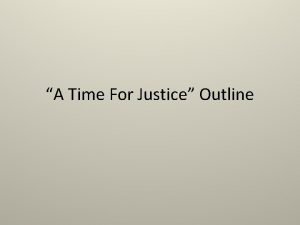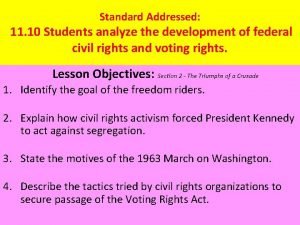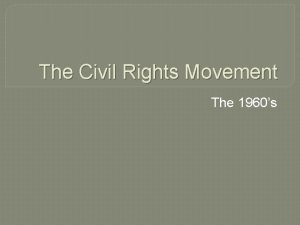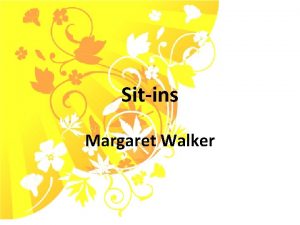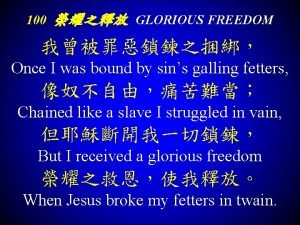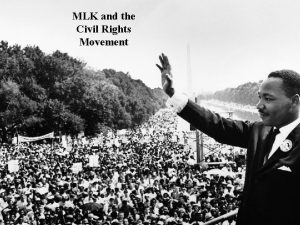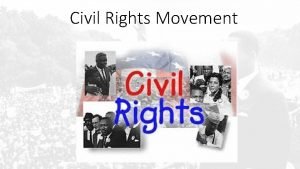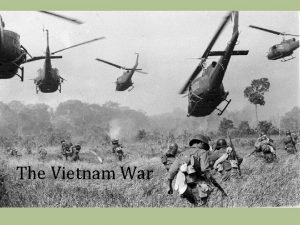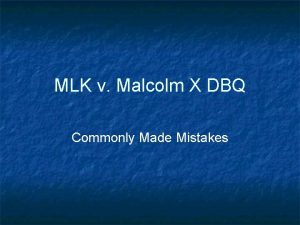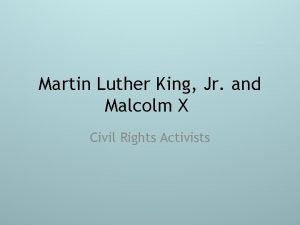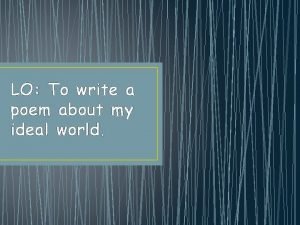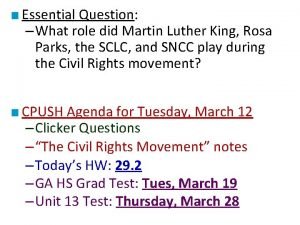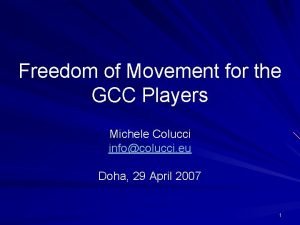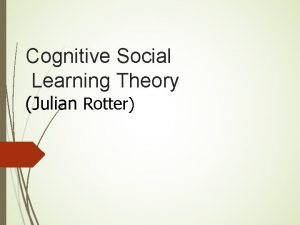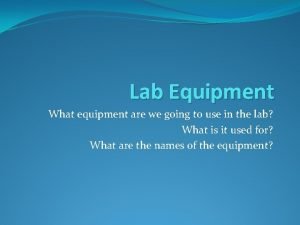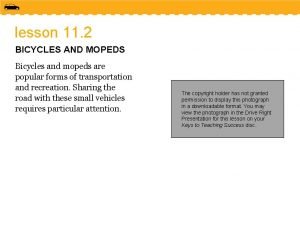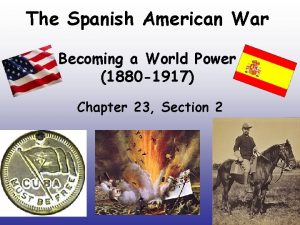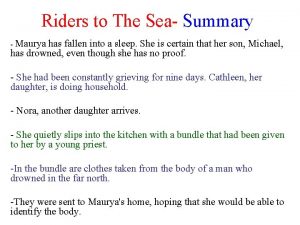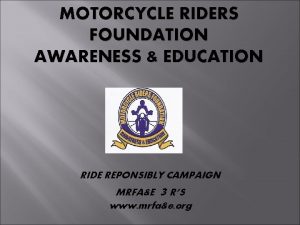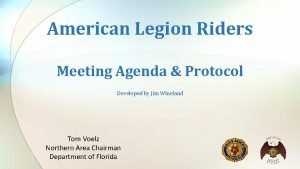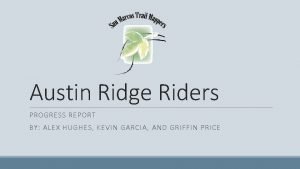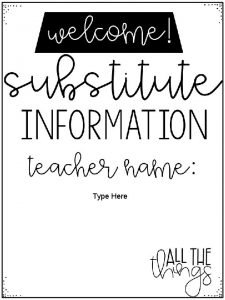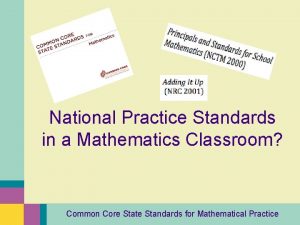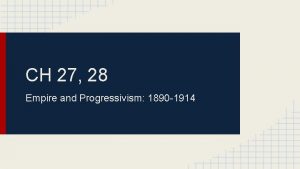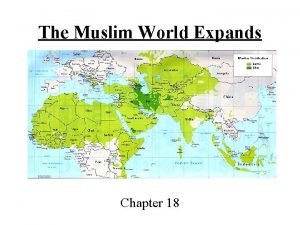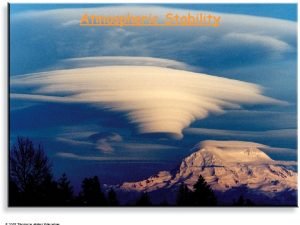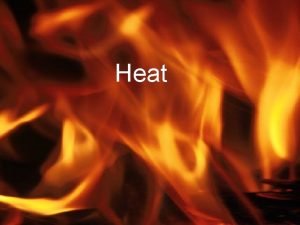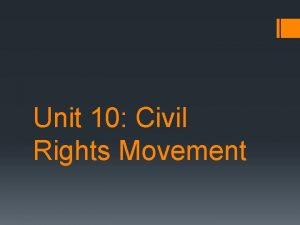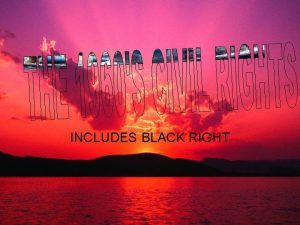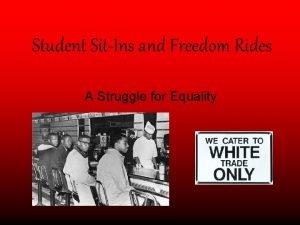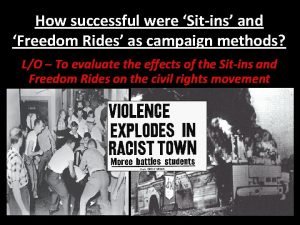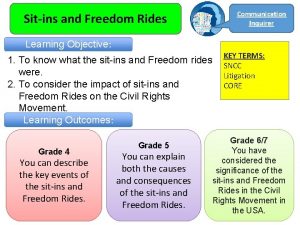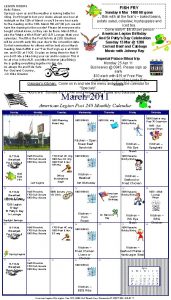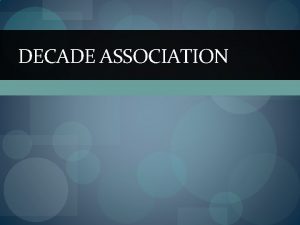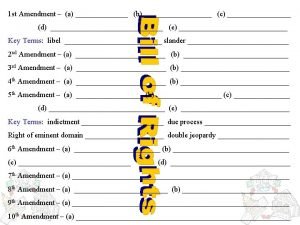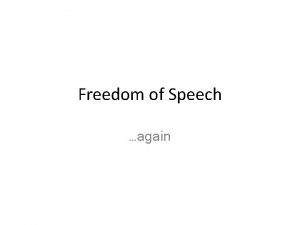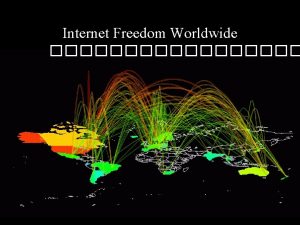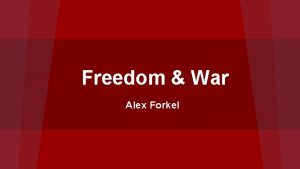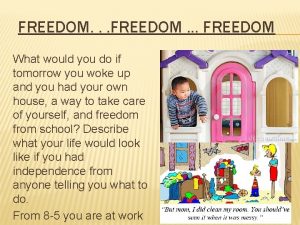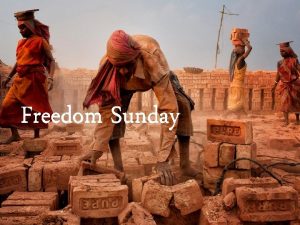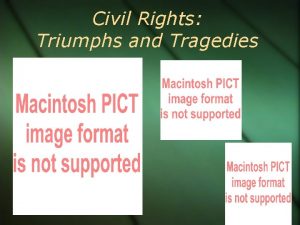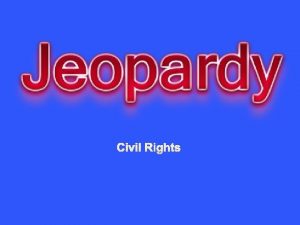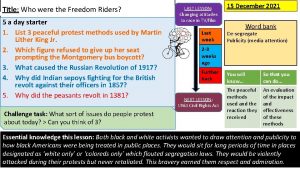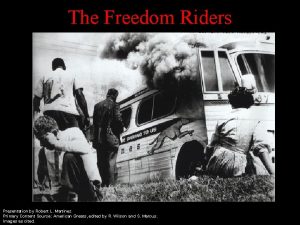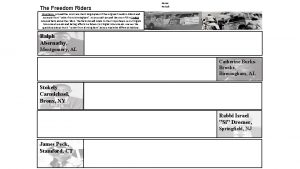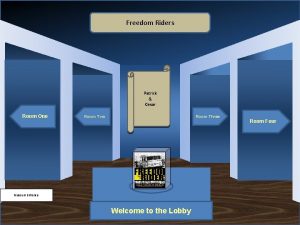The Movement Expands SitIns Freedom Riders and MLK
































- Slides: 32

The Movement Expands Sit-Ins, Freedom Riders and MLK

Make a small timeline (1954 -1965) across the top of your paper and record the following events: Brown v. Board – 1954 Emmett Till’s death – 1955 Sit-Ins – 1960 -1964 Freedom Rides – 1961 Marches in Birmingham – Spring 1963 Letter from Birmingham Jail – April 1963 March on Washington - August 1963 16 th St. Baptist Church – September 1963 Selma to Montgomery Marches – 1965

Question & Goals for Today Fundamental question: How do people demand social change? Goals for today – we will understand: The goals and effects of sit-ins, freedom rides and marches

Organizations NAACP – National Association for Advancement of Colored People Goal: Secure equality Focus: Legal realm – challenging laws (Brown vs. Board) Appealed to: Educated, middle- and upper-class African -Americans and some white Americans CORE – Congress of Racial Equality Formed in 1942 Goal: Secure social equality for African-Americans Focus – Non-violent protests

Organizations SCLC – Southern Christian Leadership Conference Founded: In 1957, by MLK Goal: Get real equality for African-Americans Focus: Large, non-violent protests (peaceful even when attacked) Impact: Moved the focus of the Civil Rights Movement to the South SNCC – Student Nonviolent Coordinating Committee Founded: In 1960, by students Focus: The experience of young African-Americans Worked with: CORE, SCLC and others

Sit-Ins

Greensboro, North Carolina Feb. 1, 1960 Students from a N. Carolina college initiated the first sit-in of the Civil Rights Movement Refused to leave a Woolworth store until they had been served

Sit-ins The Goal: Force businesses to serve African. Americans The participants: Mostly students and young people The tactic: African-Americans would sit at counters and wait to be served If they were served, they moved on to the next counter If they weren’t, they stayed at the counter in protest Faced incredibly brutal treatment

Memphis, Tennessee

Film Clip Answer the questions on your sheet: Describe how African-American students were treated. What happens after the students sitting at the counter are arrested? How do whites justify not serving African-Americans? How did the community begin to rally behind the students who were arrested? How did students involved in the movement feel about going to jail?

Effects The first sit-ins had few direct effects But other students heard about the sit-ins and CORE and SCLC started organizing additional protests

Freedom Rides Non-violent attempt to end segregation Clip- EOTP- I ain’t scared of your jails 27: 35 - 53: 45 Would you say the freedom rides were effective, or not? Why?

Marches

King organizes in Birmingham Gov. of Alabama George Wallace declared: “I say segregation now, segregation tomorrow, segregation forever. " MLK decided to focus on Birmingham, one of the most segregated cities Had closed its parks, pools and golf courses rather than integrate them

Birmingham In 1963, people began to march demanding desegregation Were arrested for marching without a permit Finally in May, 1000 Birmingham youth marched for equal rights “The Children’s Crusade” Police chief “Bull” Connor responded: Unleashed police dogs on the children Sprayed them with fire hoses with 700 lbs. of pressure

Film Clip

The Images






Responses How do you think people around the country would have responded to seeing these images?

Effects of Marches in Birmingham Across the U. S. , people were horrified by the images of the violence in Birmingham Kennedy administration intervened and pushed businesses to negotiate Ultimately, after tense negotiations, the signs mandating segregation came down The Civil Rights Movement had gained an important victory

Violence in Birmingham proved resistant to change – and violent Bombings First an integrated motel was bombed Then MLK’s brother’s home was destroyed by a bombing Shootings NAACP field rep. Medgar Evers was shot in the back 16 -year-old black Birmingham youth was shot from behind by a police shotgun 13 -year-old boy was shot while riding his bicycle

Letter from Birmingham Jail MLK was arrested for marching in Birmingham Clergymen published “Call for Unity” Argued the Civil Rights Movement should be fought in the courts, not in the street


th 16 St. Baptist Church Meeting place for SCLC A man placed a box under the steps of the church At 10: 22 AM a bomb exploded, killing four children who were attending Sunday School

Responses to MLK 8 white Alabama clergymen wrote public letter about the Marches in Birmingham - "A Call for Unity" Agreed that social injustices existed but argued that the battle against racial segregation should be fought solely in the courts, not in the streets Called King an “outsider” who was causing trouble on the streets of Birmingham

Letter from Birmingham Jail This letter is one of MLK’s most famous pieces, and is a response to the “Call for Unity”

Reading the Letter from Birmingham Jail Read the letter with your partner After each paragraph, note the main point of that paragraph on your notes paper

Letter from Birmingham Jail MLK was arrested for marching in Birmingham While imprisoned, he wrote one of his most famous pieces Read it Each paragraph = 1 bullet point summary 2 most important quotes
 Freedom riders definiton
Freedom riders definiton James zwerg
James zwerg Civil rights sitins
Civil rights sitins What were sitins
What were sitins Positive freedom negative freedom
Positive freedom negative freedom Glorious freedom wonderful freedom
Glorious freedom wonderful freedom Mlk and malcolm x venn diagram
Mlk and malcolm x venn diagram Differences between mlk and malcolm x
Differences between mlk and malcolm x Mlk and rfk assassination
Mlk and rfk assassination Mlk vs malcolm x
Mlk vs malcolm x Malcolm x
Malcolm x Mlk vs malcolm x venn diagram
Mlk vs malcolm x venn diagram My ideal world poem
My ideal world poem Diamante poem
Diamante poem Martin luther king jr timeline of events
Martin luther king jr timeline of events Martin luther king and malcolm x venn diagram
Martin luther king and malcolm x venn diagram Gcc freedom of movement
Gcc freedom of movement Basic prediction formula rotter
Basic prediction formula rotter Platform holds heating unit
Platform holds heating unit Riders of bicycles and mopeds on a roadway
Riders of bicycles and mopeds on a roadway Rough riders definition us history
Rough riders definition us history Riders to the sea sparknotes
Riders to the sea sparknotes Motorcycle riders foundation
Motorcycle riders foundation Euclidean geometry grade 11
Euclidean geometry grade 11 American legion riders patches
American legion riders patches American legion meeting protocol
American legion meeting protocol Austin ridge riders
Austin ridge riders Car riders
Car riders Revenge riders
Revenge riders What was the goal of trust busting in the early 1900s apex
What was the goal of trust busting in the early 1900s apex The muslim world expands chapter 18 answer key
The muslim world expands chapter 18 answer key Definition of unstable equilibrium
Definition of unstable equilibrium Radiate heat
Radiate heat
